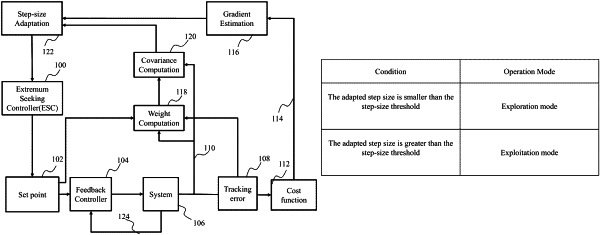| CPC G05B 13/021 (2013.01) | 16 Claims |

|
1. An extremum seeking control (ESC) system for controlling a subject system, the ESC system comprising:
at least one processor; and
a memory having instructions stored thereon that, when executed by the at least one processor, cause the ESC system to:
receive a tracking error, consecutive measurements of a system output of the subject system, and consecutive measurements of a cost function of the subject system, wherein the tracking error is a difference between a set-point of the subject system and a measurement of the system output;
estimate a gradient indicating a direction of change of the set-point of the subject system, based on the tracking error, the consecutive measurements of the system output, and the consecutive measurements of the cost function of the subject system;
determine a weight based on the tracking error and a difference between consecutive measurements of the system output;
determine a covariance of the gradient, based on the weight and the difference between the consecutive measurements of the system output;
determine a step-size based on a ratio of the covariance of the gradient to the gradient, wherein the step-size corresponds to a magnitude of the change of the set-point of the subject system; and
determine a set-point optimizing performance of the subject system, based on the direction of the change of the set-point of the subject system, and the magnitude of the change of the set-point of the subject system; and
a feedback controller configured to:
generate one or more control commands defining one or more operational parameters of the subject system, based on the determined set point; and
control the subject system according to the one or more control commands.
|